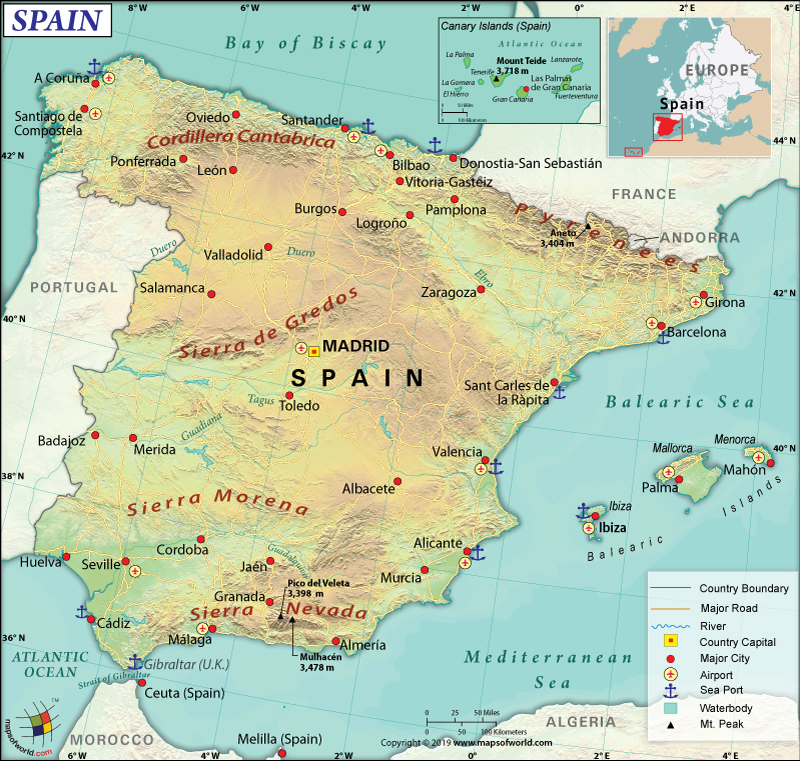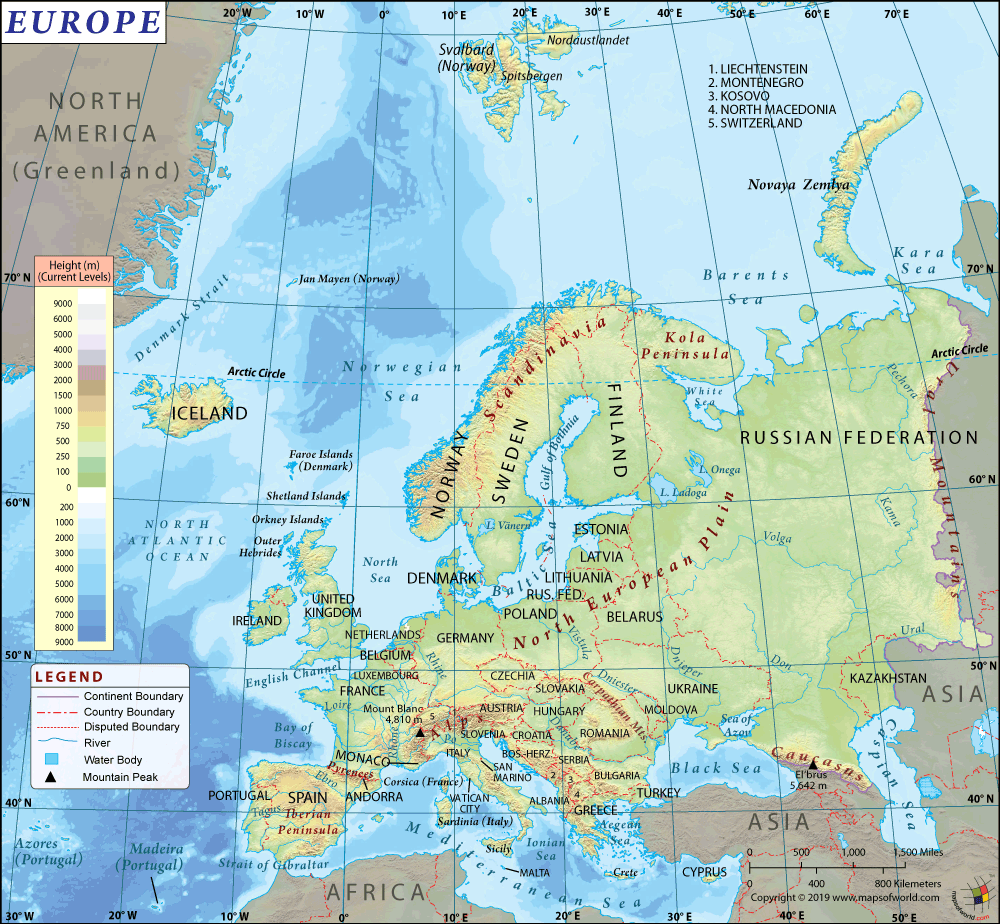What are the Key Facts of Spain?

|
Official Name |
Kingdom of Spain |
|
Continent |
Europe |
|
Capital |
Madrid |
|
Largest City |
Madrid |
|
Coordinates |
40.000000, -4.000000 |
|
Area |
195,360 sq. mi (505,990 sq. km) |
|
Land Boundaries |
1,213 mi ( 1,952.7 km) |
|
Coastline |
3,084 mi ( 4,964 km) |
|
Currency |
Euro (€) (EUR) |
|
Neighboring Countries |
France, Portugal, Morocco, Andorra, Gibraltar |
|
Population |
46,733,038 (2018 est. ) |
|
Official Languages |
Spanish |
|
Major Religion |
Christianity |
|
National Day |
12 October (National Day) |
|
National Anthem |
“Himno Nacional Espanol” |
|
Form of Government |
Unitary parliamentary constitutional monarchy |
|
Monarch |
Felipe VI |
|
Prime Minister |
Pedro Sánchez |
|
GDP per capita (PPP) |
$ 39,915.5 (World Bank, 2018) |
|
GDP per capita (nominal) |
$ 30,523.9 (World Bank, 2018) |
|
HDI |
0.891 (2017), Rank: 26 |
|
Literacy Rate (%) |
98.44 (UNESCO, 2018) |
|
Space Agency |
Instituto Nacional de Técnica Aeroespacial (INTA) |
|
Military Expenditure Ranking |
16 (SIPRI, 2017) |
|
No. of Olympic Medals |
154 (as of 2018) |
|
Driving Side |
right |
|
Calling Code |
+34 |
|
Time Zone |
UTC ±0 to +1(WET and CET), Summer (DST) UTC+1 to +2 (WEST and CEST) |
|
Internet TLD |
.es |
Where is Spain?
Spain is a Southwestern European country that is located in the southwest of France. It borders the Pyrenees Mountains, Bay of Biscay, North Atlantic Ocean, and the Mediterranean Sea. Spain occupies the majority (around 85%) of the land area of the Iberian Peninsula.
Flag of Spain
The flag of Spain has horizontal bands of red across the top and bottom, each taking up one-quarter of the flag. Between the two red stripes, the flag is a thick golden yellow band, equal in size to both the red stripes together.
What is the Geography of Spain?
Spain is spread across a total area of 505,990 sq. km (195,360 sq. mi), out of which 498,980 sq. km (192,657 sq. mi) land area and 6,390 sq. km (2,467 sq. mi) is water area. It is the 2nd largest country in Western Europe, in terms of area.
The country has two autonomous cities including Ceuta and Melilla. There are also seventeen autonomous communities in Spain, including the Canary Islands and the Balearic Islands. Off the Moroccan coast, there are 3 possessions of Spain and they are Penon de Velez de la Gomera, Penon de Alhucemas, and Islas Chafarinas.
The country has a 1,952.7 km (1213 mi) long land boundary, which is shared with 5 countries: Portugal (1,224 km or 761 mi), France (646 km or 401 mi), Andorra (63 km or 39 mi), Morocco (Melilla) (10.5 km or 6.5 mi), Morocco (Ceuta) (8 km or 5 mi), and Gibraltar (1.2 km or 0.7 mi). Between Morocco and Penon de Velez de la Gomera (an exclave of Spain), there is an additional 75 m (246 ft) border segment. Spain has a 4,964 km (16,289 mi) long coastline.
Meseta plateau is the most dominant landform in Spain, occupying around 45% of the country’s land area. This plateau mainly consists of the highland area and is rarely flat. Cordillera Central Mountains divide the highland area. Additional mountain ranges ring the concerned plateau in the south, east, and north direction. The plateau slopes downwards into neighbouring Portugal in the west.
While Pico de Teide (Tenerife) on the Canary Islands is the highest elevation point of the country at 3,718 m (12,198 ft), the lowest elevation point is the Atlantic Ocean at 0 m (0 ft). The mean elevation of Spain is 660 m (2,165 ft). The major mountains in Spain are Teide, Mulhacen, Posets o Llardana, Veleta, Aneto, Espadas, Perdido, Alcazaba, etc.
The far southern part of Spain’s landscape is dominated by the Cordillera Betica and Sierra Nevada Mountains. The fertile Andalusian Plain in the southwest, as well as the Ebro River Basin in the northeast, are the two most important landforms of the lowlands. There is a narrow coastal plain, which segregates the mountains from the sea. The coastal regions are highly indented by innumerable bays and coves. The coastline is fronted by the rugged cliffs along the Bay of Biscay in the far northwest.
Spain is separated from Morocco in Africa in the far south by the Strait of Gibraltar. Interestingly, here the European and African continents are just 13 km (8 mi) apart from each other. There are more than 1,500 rivers in Spain and the major ones are Douro, Tagus, Jucar, Ebro, Guadalquivir, Guadiana, etc.
What is the Economy of Spain?
The economy of Spain is among the top-15 largest economies in the world, in terms of nominal GDP. In 2018, the nominal GDP of the country grew by 2.4% to reach a figure of US$ 1,427,533 million. In Q1 and Q2 of 2019, the nominal GDP grew by 0.7% and 0.5% respectively.
In 2017, Spain had a negative balance of trade of US$35.7 billion. While the value of exported items was US$ 296 billion, the value of imported items was US$332 billion in 2017. The main export items are refined petroleum, cars, vehicle parts, delivery trucks, packaged medicaments, etc. The major import items are cars, crude petroleum, petroleum gas, packaged medicaments, vehicle parts, etc.
Spain’s unemployment rate was 15.49% in 2018. Around 10.2 million people or 22.3% of the population live under the poverty line.
What is the Transportation System of Spain?
Spain has a network of roadways that is 683,175 km (424,505 mi) long, out of which 16,205 km (10,069 mi) are expressways. 15,333 km (9,527 mi) of the railway network is also available, out of which 9,699 km (6,027 mi) is electrified railway network. Most of the railway network is broad-gauge (11,333 km or 7,042 mi), followed by standard-gauge (2,571 km or 1,598 mi), narrow-gauge (1,207 km or 750 mi), and 190 km (118 mi) mixed-gauge railway networks.
There are 150 airports in Spain, out of which 99 have paved runways and 51 have unpaved runways. 10 heliports are also there. 1,000 km (621 mi) of waterways are also there. Some of the major seaports are Barcelona, Algeciras, Valencia, Tarragona, Huelva, Cartagena, and Bilbao. The main seaports in the Canary Islands are Santa Cruz de Tenerife and Las Palmas.
What International Organizations is Spain part of?
WTO, IMF, WHO, UNESCO, ILO, Union Latina, Australia Group, Schengen Convention, BCIE, BIS, CD, CE, CERN, EAPC, EBRD, ECB, EIB, EMU, ESA, EU, FAO, FATF, IADB, IAEA, IBRD, ICAO, ICCt, ICRM, IDA, IEA, IFAD, IFC, IFRCS, IHO, IMO, IMSO, Interpol, IOC, IOM, IPU, ISO, ITSO, ITU, MIGA, NATO, NEA, NSG, OECD, OPCW, OSCE, Paris Club, PCA, UN, UNCTAD, UNHCR, UNIDO, UNIFIL, UNOCI, UNRWA, UNWTO, UPU, WCO, WIPO, WMO, ZC, PIF (partner), ADB (nonregional member), AfDB (nonregional member), SELEC (observer), Arctic Council (observer), CAN (observer), CBSS (observer), EITI (implementing country), ICC (national committees), ITUC (NGOs), LAIA (observer), OAS (observer), Pacific Alliance (observer), SICA (observer)
Related Links:


